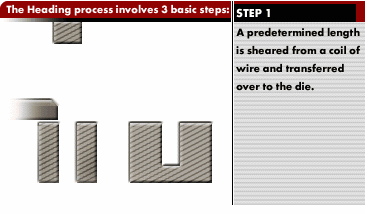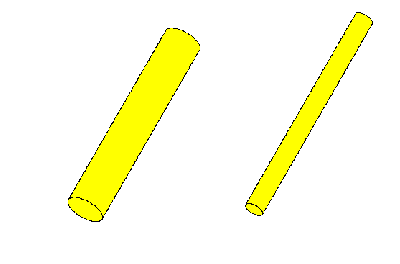Why Cold Forming?
This turn-of-the-century metal working process has evolved from the single forging processes of the past. Today's cold forming equipment can produce complex components at remarkably high speeds and with incredible accuracy. For companies currently producing or purchasing machined components, the cold forming process (also called cold heading) could be considered as an economical alternative on each and every part. Although some components may not lend themselves to the cold forming process, due to low volume requirements or incompatible shapes, the following advantages should be considered when designing a production part.

Design Versatility
The illustration above demonstrates a single die, two-blow operation, which is fairly common in our industry. However, cold forming equipment has become much more advanced in recent years. Anderson Manufacturing has sophisticated equipment featuring as many as six progressive dies. These multiple-station formers enable us to produce intricate components through a series of upset and extrusion stations.
Upsetting (increasing the diameter of the blank) and extrusion (reducing the diameter of the blank) are essential in controlling and reconfiguring the raw material into its desired final shape. Multiple-station machines make it possible to move the work through a progression of dies rather than trying to form the part in just a few blows.
High Production Rates and Repeatability
The cold forming process can operate over 100 times faster than machining, yet provide just as much accuracy. With a six-station machine, there are six parts in process, each in a different stage of development. With every stroke of the machine, a finished part is ejected from the last die while a new blank is being sheered to an engineered length and fed into the first die – all accomplished at hundreds of times per minute. Also, when we add manufacturing expertise, exceptional tool design and the use of precision tooling, cold heading offers excellent repeatability.
Reduced Scrap
The machining process begins with bar stock in the diameter equivalent to the largest diameter of the finished component being machined. This final shape is achieved by removing the bar stock thus reducing the diameters and creating scrap in the form of shavings. The higher the price of the raw material (such as copper, brass or stainless steel), the higher the loss due to the machined scrap.
Conversely, the cold forming process begins with an engineered blank and processes the material through a series of dies. The forming progression will yield a final shape through the reconfiguration of the initial blank without generating any scrap! The volume of the finished part is equal to the volume of the initial blank. The cold forming process produces no waste.

Product Strength
When machining a fastener or component, metal is cut away to reduce the diameter. By removing the metal, you also remove and "interrupt" the grain structure of the material, thus weakening the part. The part was actually stronger as raw bar stock.
A primary advantage of cold forming is the increased strength imparted to the component through the reconfiguration of the grain flow. With cold forming, no material is removed as it is during the machining process. Instead, the upsetting and extrusion processes cause the grains to be compacted, and grain flow itself will be positively altered in critical areas of the part. This rearrangement and compacting of the grain flow yields parts that are more resilient to fatigue. As a result, cold headed parts will have higher shear, tensile and yield strengths.

